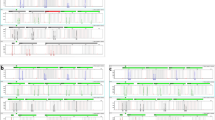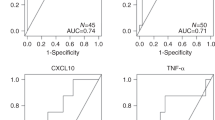Abstract
After allogeneic hematopoietic stem cell transplantation (allo-SCT), ocular GvHD is a common complication, typical symptoms being dry eye syndrome with features of fibrosis. In this study, we have identified and quantified two cell types—myofibroblasts (MFB) and polyploid (PP) cells—in the conjunctival surface of allo-SCT patients (pts) and have explored their kinetics and association with local and systemic GvHD. Results are compared with control groups of (a) pretransplant samples from allo-SCT patients, (b) recipients of autologous transplantation (auto-SCT) and (c) healthy controls. Imprint cytologies were obtained by pressing the conjunctival surface with a sterile, non-abrasive cellulose acetate filter (Millipore). After retraction, typically a monolayer of the outermost cells of the epithelium were retrieved. MFB were identified by immunofluorescent (IF) staining for alpha-smooth muscle protein. PP cells were detected by aberrant chromosome content analyzed via X/Y-FISH (X/Y fluorescence in situ hybridization). In female pts with a male donor (M→F group), donor genotype were identified by sex chromosome detection using FISH methodology. IF and FISH methods were applied in situ on the same filter, and amounts of MFB and PP cells are expressed as the percentage of all cells on the filter. In all, 70 samples from 46 pts were obtained 1–122 months after allo-SCT. The total MFB density (MFBTOT) was higher in allo-SCT pts compared with healthy individuals and auto-SCT pts and increased by time after transplantation (P<0.001). In M→F recipients, this increase proved to be due to a significant (P<0.001) and gradual elevation of donor-derived MFB (MFBXY), whereas recipient-derived MFB (MFBXX) did not vary over time. Clinical ocular GvHD correlated with MFBXY/MFBTOT ratio (P=0.034), whereas no association between MFBTOT or MFBXY systemic GvHD was observed. In the M→F group (n=25), both MFBXY and MFBXX were detected on 28 of the 37 imprints (76%). In pts >36 months post transplant, on 11/12 imprints, a median of 9.4% (1.4–39%) MFBXY and 3.6% (0–11%) MFBXX was found. In one patient, 1.6% MFBXY were detected at 3 weeks post transplant. PP cells (6–24n), exclusively of recipient origin, were found to a median of 0.6% (0–37%). The PP cell density differed significantly (P<0.001) between time intervals, with a maximum 8.9% (0–35%) of all cells at 3–12 months. No correlation between PP cells and GvHD (ocular or systemic) was observed. The MFB has been indicated as a culprit in chronic inflammation and fibrosis. The observation that MFBXY/MFBTOT ratio correlated with ocular GvHD suggests a role of donor MFB in GvHD pathogenesis. The constant finding of recipient-derived MFBXX cells many years after transplant in pts with 100% donor hematopoiesis indicates that there is a non-hematopoietic differentiation route to MFB. The origin and role of PP cells after allo-SCT remains obscure.
This is a preview of subscription content, access via your institution
Access options
Subscribe to this journal
Receive 12 print issues and online access
$259.00 per year
only $21.58 per issue
Buy this article
- Purchase on Springer Link
- Instant access to full article PDF
Prices may be subject to local taxes which are calculated during checkout



Similar content being viewed by others
References
Ogawa Y, Kodama H, Kameyama K, Yamazaki K, Yashuoka H, Okamoto S et al. Donor fibroblast chimerism in the pathogenic fibrotic lesion of human chronic graft-versus-host disease. Invest Ophthalmol Vis Sci 2005; 46: 4519–4527.
Westeneng AC, Hettinga Y, Lokhorst H, Verdonck L, van Dorp S, Rothova A . Ocular graft-versus-host disease after allogeneic stem cell transplantation. Cornea 2010; 29: 758–763.
Hinz B, Phan SH, Thannickal VJ, Galli A, Bochaton-Piallat ML, Gabbiani G . The myofibroblast: one function, multiple origins. Am J Pathol 2007; 170: 1807–1816.
Hinz G, Gabbiani G . Fibrosis: recent advances in myofibroblast biology and new therapetic perspectives. F1000 Biol Rep 2010; 2: 78.
Hallberg D, Wernstedt P, Hanson C, Wettergren Y, Stenberg K, Brune M et al. Donor-derived myofibroblasts in the ocular surface after allogeneic hematopoietic stem cell transplantation. Acta Ophthalmol 2006; 84: 774–780.
Lee HO, Davidson JM, Duronio RJ . Endoreplication: polyploidy with a purpose. Genes Dev 2009; 23: 2461–2477.
Wagner M, Hampel B, Bernard D, Hala M, Zwerschke W, Jansen-Dürr P . Replicative senescence of human endothelial cells in vitro involves G1 arrest, polyploidization and senescence-induced apoptosis. Exp Gerontol 2001; 36: 1327–1347.
Filipovich AH, Weisdorf D, Pavletic S, Socie G, Wingard JR, Lee SJ et al. National institutes of health consensus development project on criteria for clinical trials in chronic graft-versus-host disease: I. Diagnosis and staging working group report. Biol Blood Marrow Transplant 2005; 11: 945–956.
Riemens A, te Boome L, Imhof S, Kuball J, Rothova A . Current insights into ocular graft-versus-host disease. Curr Opin Ophthalmol 2010; 21: 485–494.
Egarth M, Hellkvist J, Claessson M, Hanson C, Stenevi U . Long-term survival of transplanted human corneal epithelial cells and corneal stem cells. Acta Ophthalmol Scand 2005; 83: 456–461.
Eberwein P, Faber P, Reinhard T, Finke J, Spyridonidis A . Conjunctival epithelial cells with donor-derived genome after human haematopoietic stem cell transplantation. Transplantation 2009; 87: 915–918.
Cuzick J . A Wilcoxon-type test for trend. Stat Med 1985; 4: 87–90.
Ogawa Y, Kuwana M . Dry eye as a major complication associated with chronic graft-versus-host disease after hematopoietic stem cell transplantation. Cornea 2003; 22 (7 Suppl): S19–S27.
Aguilar X, Hallberg D, Sundelin K, Hanson C, Stenberg K, Brune M, Stenevi U . Myofibroblasts in the normal conjunctival surface. Acta Ophthalmol 2010; 88: 407–412.
Seta N, Kuwana M . Human circulating monocytes as multipotential progenitors. Keio J Med 2007; 56: 41–47.
Herzog EL, Bucala R . Fibrocytes in health and disease. Exp Hematol 2010; 38: 548–556.
Keeley EC, Mehrad B, Streiter RM . Fibrocytes: bringing new insights into mechanisms of inflammation and fibrosis. Int J Biochem Cell Biol 2010; 42: 535–542.
Kuwana M, Okazaki Y, Kodama H, Izumi K, Yashuoka H, Ogawa Y et al. Human circulating CD14+ monocytes as a source of progenitors that exhibit mesenchymal cell differentiation. J Leukoc Biol 2003; 74: 833–845.
Shirai K, Sera Y, Bulkeley W, Mehrota M, Moussa O, LaRue JC et al. Hematopoietic stem cell origin of human fibroblasts: cell culture studies of female recipients of gender mismatch stem cell transplantation and patients with chronic myelogenous leukemia. Exp Hematol 2009; 37: 1464–1471.
Hanselmann RG, Oberringer M . Polyploidization: a Janus-faced mechanism. Med Hypotheses 2001; 56: 58–64.
Acknowledgements
The authors are grateful for the statistical help from Harald Anderson PhD, Lund, Sweden.
Author information
Authors and Affiliations
Corresponding author
Ethics declarations
Competing interests
The authors declare no conflict of interest.
Rights and permissions
About this article
Cite this article
Hallberg, D., Stenberg, K., Hanson, C. et al. Conjunctival polyploid cells and donor-derived myofibroblasts in ocular GvHD. Bone Marrow Transplant 51, 692–697 (2016). https://doi.org/10.1038/bmt.2015.347
Received:
Accepted:
Published:
Issue Date:
DOI: https://doi.org/10.1038/bmt.2015.347



